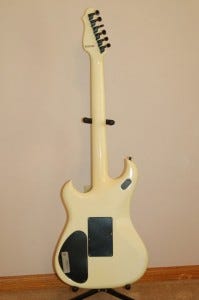I Finally Have A Westone Spectrum FX... Just Have To Drive To St. Louis To Get It
I've been writing and talking about the Matsumoku Electras/Westones/Arias/Skylarks and the Golden Era of Japanese guitar-building quite a bit lately. In a way, it was a lot like the age of the dinosaurs; in the relatively short period between 1975 and 1986, the guitars became vastly more specialized, complex, and expensive. The earliest "Uncle Mat" guitars were Les Paul copies; the final ones arrived in a bewildering variety of colors, shapes, capabilities, and tonal possibilities. Then the meteor hit.
Among the spiky and multi-featured Cretaceous Matsumokus of 1986, the final-production Westone Spectrum FX, demoed above by my friend "Proendorser Mike", is the Tyrannosaurus Rex.

That's a photo of the Spectrum FX my man ultra sonic picked up for me in St. Louis last night. I'll have to make a drive to St. Louis to get it, but that's a small price to pay for an example like this. It's a second-generation Spectrum FX. The first-generation FX was basically an Electra X199; a sleek, set-neck super-Strat with eighteen different pickup combinations, a deep-bend-optimized tremolo, and the highest grade of workmanship Matsumoku could bring to the table. When St. Louis Music decided to use the "Westone", rather than the "Electra" name, for their US-market guitars, the X199 simply became the Spectrum FX.
In 1986, however, Matsumoku added the "heel-less" construction that had proven popular in the Electra X935 "Endorser", only with an even deeper cut.

There's something almost too perfect and evolved about the Spectrum FX. It doesn't have a sharp edge on it anywhere. It can accurately re-create almost any electric guitar tone you'd want; for a cover band, it would be invaluable. There's a lot of magnet under the strings, which isn't great for sustain, but the solid maple body and neck go some way to bring that back. It can perform Vai-style bends without difficulty but it can also imitate Page's Les Paul. Or Page's Telecaster. It's such a brilliant tool for the purpose, and it sold for a reasonable price: $499 in 1985, which would be $1050 today. The equivalent modern guitar would be an Ibanez S5470 Prestige, which costs $1999.
The comet that killed this tone tyrannosaur was financial. As the yen climbed sharply in 1985 and 1986, from 238 per dollar to 168, the price of the Spectrum FX climbed as well. My 1986 Spectrum FX in Candy Red sold for $699, about $1450 in today's money. That's a 50% price bump in twelve months. The market didn't take it well. In 1987, Westone production for St. Louis Music was moved to Korea. The Matsumoku plant acquired the Westone name for European sales and continued to supply them until 1990 or so before shutting down. The giants no longer walked the earth.
Matsumoku's loss was Fender's gain. The Corona plant opened in 1986 and all of a sudden you could buy an American-made Stratocaster for the same price as a bolt-neck Westone Spectrum LX. Japanese electric guitars are a rare curiosity in the US nowadays; domestic manufacturers hold the high ground, China vomits out a stream of junk at the $699 price point and below, Korea makes a few Gretsches and whatnot. It's interesting to think what might have been had the yen not skyrocketed. Would Fender and Gibson have had their renaissance? Would we have much of an American guitar industry left today, or would the American guitar manufacturers have suffered the fate of their automotive counterparts?
A postscript to this story: Today, the vast majority of Heritage guitars, and a significant amount of Gibson and PRS production, are shipped to Japan. The Japanese love American guitars and they saw the yen's climb as a chance to have the Les Paul or ES-335 they'd wanted all along. They are active buyers, collectors, and participants on American guitar forums. But when it comes to Matsumoku collecting, they're silent. "Uncle Mat" was a prophet without honor in his homeland, or so it would appear.

